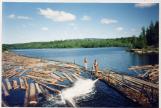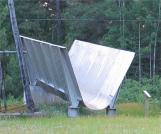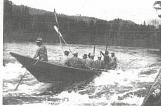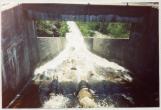2
Beginning in the 1880's an association of lumber companies used Pointer Boats to clean or "sweep" grounded logs from shallow rapids, shoals and beaches along the Ottawa River. From 1867 the Upper Ottawa Improvment Company (ICO) , also an association, operated slides and booms along the river. Today (1970) it has 28 tugboats and 300 employees and operates from Ottawa to the head of Lake Temiskaming .The Pointer Boat was designed in Ottawa in the 1850's by John Cockburn. From 1866 his shop was in Pembroke, Ontario where his grandson, John A. Cockburn continued the family buisness until 1969
4
The Pointer Boat was designed in Ottawa in the 1850's by John Cockburn. From 1866 his shop was in Pembroke, Ontario where his grandson, John A. Cockburn continued the family buisness until 19695
With the construction of the Dam at Des Joachims, logs could no longer be moved on the river current. They now had to be assembled into booms at Mattawa, towed by tugboat the 80 km (50 miles) to the Dam and put through the log chute.While this was a new and additional cost to the lumber companies it is not clear whether in the total picture it was a plus or a minus. Gone were the damage caused to the logs in the rapids and the costs of dealing with log jams. Also greatly reduced was the need for the "Sweep". The sweep was an operation in which teams of men in pointer boats swept both shores of the river, recovering logs which had become stranded on shore or in the shallows and putting them back in the current.
7
REMINISCENCES; Les Raymond(37 years on the Tug-Boats)
Well in Mattawa they had a log dump just east of Valois' [restaurant]. The trucks would bring logs in and they'd dump them into the boom we had at the wharf. When that boom got filled up, we'd tow the logs down the river about two miles below Valois' where we had a holding area. We'd make our tows from there and tow them down to the Swisha.
There were three men on a boat; on the bigger boats there were four.
The tugs didn't move very fast. We had a three to one reduction from the engine to the prop [propeller] - the engine would turn three times faster than the prop would. And that's a 36 inch prop on the forty foot tugboat by a six cylinder diesel engine, if everything was going good and let's say no wind was blowing, we could go about three quarters to a mile an hour. Yeah, and if you had a good tail wind you could make maybe two miles an hour.
We'd leave Mattawa on Tuesday morning and, if everything went fair, we'd be down at the dam here [in Rapides des Joachinis] Friday at noon towing steady - twenty-four hours a day. If we were caught in the fog with our load and we didn't know where we were, we'd just drop the anchor and hold everything until the fog cleared up. We had, oh, almost a mile of 5/8 inch cable on the anchor - a 650 lb. anchor. That would pretty well hold your load for you.
For us work was long, and that was about it. You were away from home all week, and that wasn't very nice I guess. But most of the time I was home on the weekends. In the earlier days we used to work 'til Saturday noon, eh, and sometimes the full week end. You wouldn't make it home for two weeks, and that would make me upset 'cause I was a teenager then.
Well, the hardest part of my job was tryin' to stay awake. Other than that it was pretty nice, especially in the mountains at night. Unless you were in certain sections of the river where there were a lot of lights, you could pretty well make out the outline of the mountain.
After towing logs on the river for so long at night you get to know the little 'V' in the mountain where you are. 'Bout the only time we could use a compass was from Stonecliffe down to the Swisha. It was generally on a Friday morning early when we were hitting that section of river - 'course we wanted to get home, eh? So if we got a bearing before the fog rolled in, we could go for four or five hours, towing in the fog. We'd do it just to make time
We used to always carry an ice box made out of plywood on the back of the boat 'cause we didn't have fridges in those days. We kept all our meats and everything in there for the week. Later on we got propane fridges and propane heat in the bedroom in the bow of the boat.
Before that we didn't have any heat, so in the spring and in the fall it got pretty cold in there at night, especially when the ice was still in the water. We slept right on the tugs - four bunks down below deck and two bunks in the wheelhouse.
I've seen me go to bed at night in the boat, put more clothes on just to be warm, cover up and sleep with the little door between the engine room and the bed room open so I could get some heat off the engine.
We usually started around the end of April -it depended on when the ice got off the river. Then some times we used to run right into November. The ice would be forming before we'd finish up, so it would be getting pretty cold. We broke ice a few times.
In the fall of the year, after all the towing was done, we'd go along the shores and pick up the logs that would get out of the boom and drift in on the shore.
8
Workers moving logs into the log chute at the Des Joachims Dam1990
Des Joachims, Ottawa River, Ontario/Quebec, Canada

9
Workers moving logs to log chute at the Des Joachims Dam1990
Des Joachims, Ottawa River, Ontario/Quebec, Canada

10
REMINISCENCES -Les Raymond (Continued)At the dams they used to have maybe six men on either side of the boom with pike poles, pushing the logs through, down to the log chute. Technology changed all of that. We got this big pump plugged in at the dam [Ontario Hydro Electric] and the water pressure would push the logs through.
Well, the crew that put the logs through the dam and looked after the Swisha boom stayed at the camp [the ICO camp above the Rapides des Joachims Dam]. The camp up on the hill was a sleep camp, and the main camp, that was the cooker, and then the one down below it was the store house and office.
Of course, in the early days there was up to 16 men staying there with a Cook. There was only two or three guys there at the end.
12
Well, the crew that put the logs through the dam and looked after the Swisha boom stayed at the camp [the ICO camp above the Rapides des Joachims Dam]. The camp up on the hill was a sleep camp, and the main camp, that was the cooker, and then the one down below it was the store house and office.Of course, in the early days there was up to 16 men staying there with a Cook. There was only two or three guys there at the end.
13
A section of the log chute from the Des Joachims dam1994
Schoolhouse Museum grounds, RR#1 Deep River, Ontario




